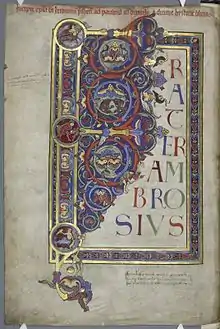Bury Bible
The Bury Bible is a giant illustrated Bible written at Bury Saint Edmunds in Suffolk, England between 1121 and 1148, and illuminated by an artist known as Master Hugo.[1] Since 1575 it has been in the Parker Library of Corpus Christi College, Cambridge, with the shelf-mark Cambridge CCCC M 2.[2]

It is an important example of Romanesque illumination from Norman England, and bears comparison with other giant bibles produced in England in the 12th century such as the Dover Bible (also in the Parker Library), Lambeth Bible, Rochester Bible, and the Winchester Bible.[3]
Description
Only the first part of the original two-volume work has been preserved. Twelve pictures were painted on parchment on separate pages and then incorporated into the work; six remain. 42 of the original 44 painted initials have been preserved.[4] [5] [6]
The preserved portion of the Bible is bound in 3 volumes, with dimensions 52.2 cm high by 36 cm wide. They contain 357 folios in total. [4]
References
- R. M. Thomson, ‘The date of the Bury Bible reexamined’, Viator, 6 (1975), 51–8.
- C. M. Kauffmann, "The Bury bible (Cambridge, Corpus Christi College , MS. 2" Journal of the Warburg and Courtauld Institutes, no/ 29, 1966, p. 60-81
- M Kauffmann: Romanesque Manuscripts 1066-1190. Survey of Manuscripts Illuminated in the British Isles . London, Boston 1975, pp. 86ff.
- Rodney M. Thomson, The Bury Bible [Facsimile] Boydell Press, 2002, 102 p. (ISBN 978-0851158556)
- . A. Heslop, ‘The production and artistry of the Bury Bible’, Bury St Edmunds: medieval art, architecture, archaeology, and economy, ed. A. Gransden (1998), 172–85